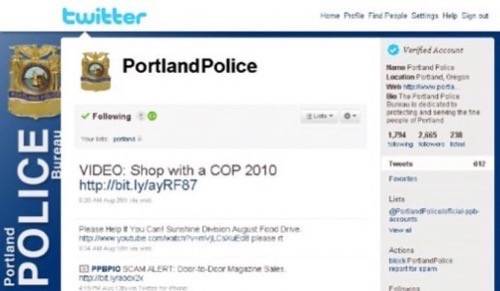A study of 1,089 official and unofficial law enforcement Twitter accounts shows about 21 percent don’t tweet, nine percent tweet personal opinions about crime or criminal justice, and three percent have tweeted in a way that could be interpreted as racist or sexist.

Furthermore, the vast majority of agencies did not include legal disclaimers or refer to a social media policy on their Twitter accounts.
The official Twitter page for the Portland Police Bureau, @PortlandPolice.

The study covered accounts in the U.S., U.K. and Canada, and concluded that there is no consensus for how police should conduct themselves on Twitter. It was conducted by the Canadian Association of Police on Social Media, a group of police, academics and citizens that advocates the use of social media by police (check out this guest post by co-founder Laura Madison, The Dark Figure Of Social Media: What Can Twitter Teach Criminologists?).
“The lack of legal disclaimers (e.g. “The opinions expressed here do not reflect those of my employer” or “This account is not monitored 24/7; please do not use it to report crimes”) and social media policy (which may include disclaimers as well as purpose and other information) is of concern,” the study’s authors conclude.
A disclaimer seems especially wise for police accounts given that a recent Red Cross report showed half of social media users believe emergency responders are monitoring social media (see our coverage: 74% of Social Media Users Expect Cries for Help to Be Answered Within an Hour).
Just one account had a link to a social media policy from Twitter – The New Scotland Yard, Metropolitan Police in London, @metpoliceuk. The policy tells users to expect updates on the latest news stories from New Scotland Yard, alerts about items posted to Flickr and YouTube and “in the event of a major incident,” information from the agency’s website. It also explains who is behind the account, when it is monitored and even its followback policy. However, the account has yet to tweet.
Alarmingly, the study also found that 15 police accounts tweeted sensitive legal information, such as clues that could identify suspects of victims of crimes. That’s less than one percent, but police officers should know not to publicly broadcast information that could compromise ongoing investigations, inaccurately implicate someone who has not been proven guilty of a crime, or lead an at-large criminal to a victim.
Police tweeted mostly about missing persons, wanted suspects, traffic and safety, arrests and other on-duty activity. But agencies and officers seemed to have no strategy for Twitter use, the study concludes.
CAPSM recommends that police agencies use Twitter more and experiment with third-party and mobile applications. It also recommends that agencies clarify the way they plan to use Twitter and train their officers accordingly.
The group also encourages police agencies to use Twitter to preempt brand hijacking via fake accounts, such as this one in Portland:

“That more police are using Twitter to connect with their communities is encouraging. However, they should take care not to use it only because it is popular or because the neighboring agency signed on. Instead, they must recognize it in the context of public communication at large: who uses it, how they use it, and where it can fit into various types of police operations,” the study concludes.
UPDATE: CAPSM contacted us to say that its main takeaway was that police are “doing quite well and learning a few things” and “the numbers supporting the quality of tweets are very encouraging. It means that more and more citizens are getting important real time safety news delivered right to them.”
There are agencies on Twitter who are using the medium effectively to communicate with the community and enhance their policing – the Portland Police Bureau, referenced above, is a good example – and we didn’t mean to suggest otherwise. Rather, our takeaway was that the wide variation in the ways police use Twitter, the fact that some are not using it at all, the absence of clearly denoted social media policies, and the instances of misuse added up to an uncertainty about using the medium – which CAPSM’s recommendations for a “best practices” approach would likely remedy.










